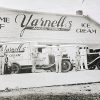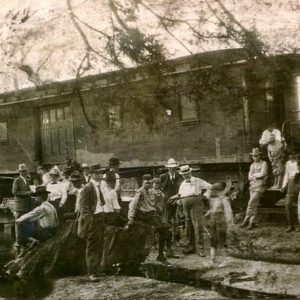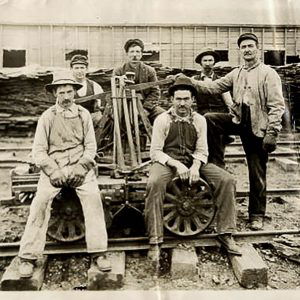calsfoundation@cals.org
Jonesboro, Lake City and Eastern Railroad
The Jonesboro, Lake City and Eastern Railroad (JLC&E) was chartered in 1897 and operated in northeastern Arkansas until being sold to the St. Louis–San Francisco Railway Co. (SLSF), better known as the Frisco, in 1925. The company provided a vital service to the people of the region for over twenty-five years and was crucial to the area’s development.
Although there were several railroad lines in northeastern Arkansas by the 1880s, they had not ventured into the sunken lands created by the New Madrid Earthquakes of 1811–1812. However, the expanding timber business demanded a better way to transport its product to sawmills. In the East Bottoms of northeastern Arkansas before 1895, the logs were conveyed by oxen pulling broad-wheeled wagons along the muddy trails. It was a slow and arduous journey in dry weather and nearly impossible in wet weather. Investors knew they needed a railroad but had no idea how to build one on the unstable terrain. A group of prominent men in Jonesboro (Craighead County), led by the F. Kiech Manufacturing Company, received a charter from the State of Arkansas in April 1897 to build the Jonesboro, Lake City and Eastern Railroad.
By June, crews had cleared the right-of-way, dug ditches on either side of the tracks, and graded the terrain. By September, everything was in place to begin laying tracks. However, the necessity to build bridges over the numerous ditches and sloughs of the bottomlands posed a huge problem. Bridge pilings, cut from area timbers, were driven into the soft ground, but the bridges that were built could only accommodate lightweight trains. The temporary nature of the bridges caused maintenance problems for many years. By the end of November 1897, the first train of the JLC&E left Nettleton (Craighead County) for the twelve-mile trip to Lake City (Craighead County).
The JLC&E began the expansion of its railroad across the St. Francis River at Lake City to nearby Cane Island and Buffalo Island in June 1898. Once a bridge/trestle was completed, the ground work began. The work progressed quickly. On August 19, 1898, the inaugural train reached Monette (Craighead County), nearly ten miles away. Although this line was only an excursion special, the company realized that the potential for future profits was immense.
The railroad was responsible for boom towns along its route. Monette and Black Oak in Craighead County, and Leachville in Mississippi County, grew exponentially with the railroad’s expansion.
Eventually, the JLC&E recognized the need to expand the railroad line to Blytheville (Mississippi County), twenty-five miles east of Leachville. Additionally, the company wanted to take advantage of the prolific game, fish, and timber around Big Lake, three miles east of Manila (Mississippi County). As the first train arrived on the newly expanded rails to Manila on December 2, 1900, the JLC&E was already building a trestle across the Little River on its route to reach Blytheville. By late 1902, the JLC&E joined its tracks to the St. Louis, Memphis and Southeastern (StLM&SE) line.
The company’s expansion increased revenue along the railroad lines by opening the area to timber operations, which included the construction of several sawmills and general stores. In addition, freight and passenger traffic increased from Jonesboro to Blytheville.
By early 1904, the Chickasawba Railroad Company finished a new railroad on the JLC&E line, which reached the Mississippi River at Barfield Landing. The Chickasawba line intersected with the JLC&E and StLM&SE at Blytheville.
By 1910, rumors circulated that the JLC&E was for sale. The reports were substantiated on March 1, 1911, when prominent Mississippi County plantation owner Robert E. Lee Wilson purchased the railroad for $200,000.
Although there was constant activity at the railroad, the JLC&E had experienced its share of problems. Floods and overflows in 1912 and 1913, strikes by members of the Railroad Brotherhoods in 1915, new taxes for drainage districts, and the fact that the company had not paid a dividend to shareholders since 1911 caused a variety of difficulties for Wilson. However, World War I ushered in general price increases and greater demand for cotton, food staples, and lumber. The JLC&E added two coal-powered locomotives in May 1916 to handle the increased freight business, but it still failed to make a profit. Despite a land boom in northeastern Arkansas that fostered more and more railroad traffic, revenues remained small.
By 1923, the industry was changing to pursue more passengers, and the era of the “Bull Moose” began. More-comfortable, fast-moving trains accommodating businessmen, shoppers, and students appeared. Schedules were created to cater to the clientele, but passenger business for the JLC&E continued to decline. The railroad also had a hard time competing with the ease of travel brought by an increase of new hard-surfaced roads, cheap automobiles, and bus lines.
On July 7, 1925, an Associated Press dispatch reached Arkansas that stated the Frisco Railroad had purchased the JLC&E.
For additional information:
Dew, Lee A. The JLC&E: The History of an Arkansas Railroad. Jonesboro: Arkansas State University Press, 1968.
McKinnon, Hazel, ed. “Train Service Comes to Buffalo Island in 1898.” Northeast Arkansas Town Crier, Bicentennial Issue, June 17, 1976.
Donna Jackson
Manila, Arkansas








Comments
No comments on this entry yet.